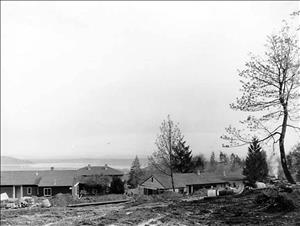When View Ridge was developed for homes, there was a ridge, but no views. Lake Washington was nearby, but you couldn't see it for the trees. During the Great Depression, two veterans of radio broadcasting changed that. With $25 down, they started clearing land and grading streets. By masterfully managing publicity, partners Al Balch (1903-1976) and Ralph Jones (1903-1996) outpaced better financed projects nearby. View Ridge became a neighborhood in northeast Seattle just west of Sand Point.
This area west of Sand Point saw little in the way of settlement in the nineteenth century. The Sand Point Peninsula and the shore of Lake Washington first attracted loggers interested in the tall stands of fir and cedar. After them came a few farmers who took advantage of newly cleared land. Even the construction of the Seattle, Lake Shore & Eastern Railroad (later the North Bend Branch of the Northern Pacific) and the establishment of the Pontiac Brick Co. did little to bring people to the steep hillside above the lake. In the 1890s, a recreational visit to Sand Point was a two-day trip.
In the 1920s, the U.S. Navy occupied Sand Point for an air station. Development in Seattle tended to follow trolley lines and highways. Sand Point Way was a dirt (or mud) track. Eventually, the street was improved and Seattle and Sand Point continued to grow. The Northern Pacific offered some railroad passenger service to Pontiac station, but that ended in 1938.
The Plan
In 1935, Seattle struggled out of the Great Depression. Ralph Jones and Albert Balch decided to become real estate men. They met while working for radio stations owned by the Fisher family. Jones was a newsman and Balch sold the ads. Seattle physician Carl Neu owned 10 acres of second-growth forest at NE 65th Street and 50th Avenue NE, but he couldn't pay the taxes. Balch and Jones bought the property with $25 down, with a balloon payment of $1,000 due in a month. They went to the county assessor and platted View Ridge, the first new real estate project in the county in more than two years.
Jones and Balch started clearing land. They cut trees and graded streets and lots. Slash was pulled into large piles and burned in great bonfires, events that made their way into the newspapers. Removing the trees exposed stunning views of Lake Washington and the Cascades. The first houses that they built were for themselves on 50th Avenue NE.
It's All in the Presentation
Jones (University of Washington, 1922) collared his fraternity brothers to buy lots. He advertised in the academic community. The partners hosted picnics to attract buyers to the area.
Lots went for $450 to $950. Sales agreements included a review of building plans by a committee. Homes had to be set back from the streets to preserve views. Jones and Balch used their knowledge of the media and publicity to push their project. When lots sold, the partners arranged for news items reporting the sales.
The project got a big boost in 1938 when Life ran a 22-page magazine spread on homes that could be built for $2,000 to $10,000. Three of the featured houses were in View Ridge. The partners obtained reprints that were distributed to buyers.
Nearby, Hawthorne Hills was being developed too, with paved streets, sewers and utilities. View Ridge had none of these at first. Jones and Balch arranged for water and homes were connected to septic systems. Seattle City Light and Puget Sound Power and Light muscled each other to provide electrical service and two sets of power lines cluttered utility poles.
More
But View Ridge had publicity and sales that surpassed those in Hawthorne Hills. Success allowed the partners to expand the project. NE 70th Street was cut through the slash to 35th Avenue NE. View Ridge grew until it stretched from NE 65th Street to NE 75th Street and from 40th Avenue NE to Sand Point Way NE.
The neighborhood experienced a second surge in sales during World War II, when construction materials were in short supply. The views were great, but the amenities were not great. Residents collected money from among themselves to oil the unpaved streets in the summer. Sand Point bustled with noisy activity as air crews prepared for battle in the Pacific. The area was annexed into the city of Seattle in 1942. View Ridge Elementary School opened the doors of its four portable classrooms in November 1944. The permanent building was completed in the fall of 1947.
In a 1990 interview, Ralph Jones told reporter O. Casey Corr that the restrictions on sales did not include racial discrimination, which was common in Seattle before 1968. However, Jones's statement is incorrect. A covenant on a View Ridge property dated January 23, 1950, signed by Albert Balch, states that "No person of any race other than the white Caucasian race shall use or occupy any building or lot," in View Ridge Park Nos. 4 and 5. [HistoryLink.org received a copy of the covenant in December 2005.] Jones stated that an African American engineer from Boeing once looked at property in View Ridge, but Jones talked him out of buying because of the long commute.
The views were enhanced during the 1960s when the overhead utilities were placed underground. Quiet descended upon the neighborhood in 1970 when Sand Point ceased to be a Naval Air Station. View Ridge residents lobbied hard to insure that the property would not be another airport. The land below View Ridge became Magnuson Park.
In 1988, the last unsold lot in View Ridge sold for $100,000. Balch and Jones lived in the homes they built for the rest of their lives.

